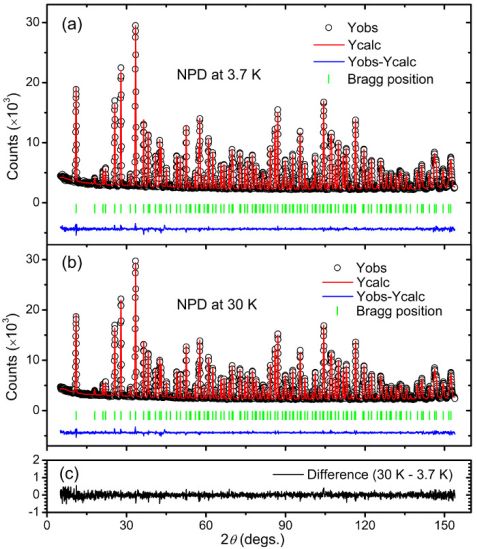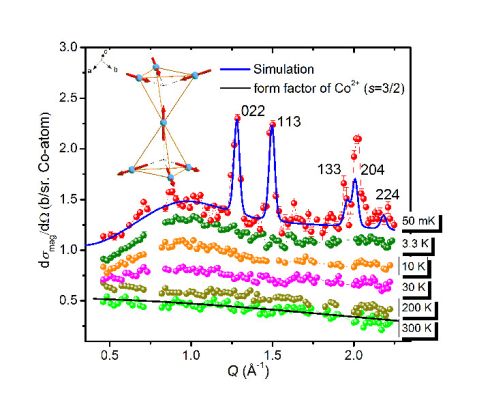MLZ is a cooperation between:
 > Technische Universität München
> Technische Universität München > Helmholtz-Zentrum Hereon
> Helmholtz-Zentrum Hereon
 > Forschungszentrum Jülich
> Forschungszentrum Jülich
MLZ is a member of:
 > LENS
> LENS > ERF-AISBL
> ERF-AISBL
MLZ on social media:

MLZ (eng)
Lichtenbergstr.1
85748 Garching
Novel magnetic orders and spin-glass-like phase in Na3Co(CO3)2Cl
Z. Fu1, Y. Zheng2, Y. Xiao3, S. Bedanta4, A. Senyshyn5, G. Simeoni5, Y. Su1, U. Rücker3, P. Kögerler6, and Th. Brückel3
1Jülich Centre for Neutron Science (JCNS) at MLZ, Forschungszentrum Jülich GmbH, Garching, Germany
2Frontier Institute of Science and Technology, Xi’an Jiaotong University, Xi’an, China
3JCNS-2, PGI-4: Streumethoden, Forschungszentrum Jülich GmbH, Jülich, Germany
4School of Physical Sciences, National Institute of Education and Research, Orissa, India
5Heinz Maier-Leibnitz Zentrum (MLZ), Technische Universität München, Garching, Germany
6Institut für Anorganische Chemie, RWTH Aachen University, Aachen, Germany
Pyrochlore magnets have been attracting intensive attention in the study of geometrical spin frustration and still hold surprises for exotic magnetic ground states. Neutron scattering technique is essential for a deep understanding of the complicated magnetic behaviour of frustrated magnets. Our research on pyrochlore antiferromagnet Na3Co(CO3)2Cl reveals a unique coexistence of novel magnetic orders and a spin-glass-like phase. Neutron powder diffraction on SPODI identifies a chemically-ordered cubic structure of the sample. Polarized neutron scattering on DNS confirms an all-in-all-out type of long-range magnetic order below 1.5 K. Inelastic neutron scattering on TOFTOF shows spin-wave-like excitations at 3.7 K, indicative of an unconventional spin glass transition at 4.5 K.
Frustrated pyrochlore magnets have been attracting intensive attention owing to the new intriguing phases discovered, e.g., magnetic monopoles and Higgs transition in spin ice systems. [1,2] In antiferromagnetic pyrochlores, the high ground-state degeneracy can be lifted by perturbations from further-neighbour interactions, resulting in interesting magnetic behaviour. The formation of a spin-glass phase generally requires both chemical disorder and frustrated interactions. However spin-glass-like behaviour has been observed in a few examples of pyrochlore magnets which are chemically ordered. The origin of this spin-glass-like behaviour has not yet been understood.
A new spin-frustrated antiferromagnetic pyrochlore Na3Co(CO3)2Cl was discovered. The temperature dependence of AC susceptibility shows that Na3Co(CO3)2Cl undergoes a spin-glass-like phase transition at 4.5 K and exhibits collective magnetic behaviour at 17 K. The specific heat measured down to 60 mK reveals a long-range magnetic phase transition at 1.5 K. [3]
Neutron powder diffraction at SPODI
In order to identify the average crystal structure and possible atomic disorder in Na3Co(CO3)2Cl, we performed neutron powder diffraction (NPD) on SPODI. The experimental NPD patterns for 3.7 and 30 K are shown in figure 1, together with the Rietveld refinement with the space group F d -3. Satisfactory refinement was obtained without introducing any magnetic contribution. No clear evidence for atomic disorders has been found within the resolution of SPODI.
Polarized neutron scattering at DNS
Diffuse neutron scattering with polarization analysis was performed on DNS to detect short-range spin correlations and long-range magnetic order in Na3Co(CO3)2Cl. The nuclear coherent, spin-incoherent and paramagnetic scattering contributions were separated unambiguously using the xyz-polarization method. Figure 2 shows the differential magnetic cross section dσmag/dΩ measured on DNS at various temperatures. At 50 mK, long-range magnetic order is evidenced by clear magnetic Bragg peaks superposed on the magnetic diffuse scattering. Symmetry analysis based on the representation theory shows an all-in-all-out spin configuration for the Co2+ spins (see the inset of figure 2).
An analytical simulation of short-range spin correlations in Na3Co(CO3)2Cl was carried out by attempting a least-square fit to the measured magnetic scattering cross section with the following Fourier transform of spin-pair correlation functions,

The best fit was achieved when introducing dominating antiferromagnetic nearest-neighbour interactions and weak ferromagnetic next-nearest-neighbour interactions. The fitting results of the short-range spin correlations and the magnetic reflections are plotted as the blue line in figure 2.
Time-of-flight inelastic neutron scattering at TOFTOF
The spin dynamics of Na3Co(CO3)2Cl is explored by means of inelastic neutron scattering on TOFTOF. Figure 3 shows the contour plot of the dynamic structure factor S(Q, ω) at 3.5 and 15 K. The scattering intensity indicates a modulation due to the magnetic form factor and thus should be of magnetic origin. Spin-wave-like excitations can be seen centering at around 0.9 Å-1 at 3.5 K, indicating that the transition at 4.5 K is not a conventional spin glass transition.
In conclusion, by means of extensive experimental investigations, we have revealed a novel coexistence of a long-range magnetic order, an intermediate partially-ordered magnetic phase, and a spin-glass-like phase, in one antiferromagnetic pyrochlore, Na3Co(CO3)2Cl.
References:
[1] D. J. P. Morris et al., Science 326, 41 (2009).
[2] L.-J. Chang et al., Nat. Commun. 3, 992 (2009).
[3] Z. Fu et al., Phys. Rev. B 87, 214406 (2013).
MLZ is a cooperation between:
 > Technische Universität München
> Technische Universität München > Helmholtz-Zentrum Hereon
> Helmholtz-Zentrum Hereon
 > Forschungszentrum Jülich
> Forschungszentrum Jülich
MLZ is a member of:
 > LENS
> LENS > ERF-AISBL
> ERF-AISBL
MLZ on social media:





